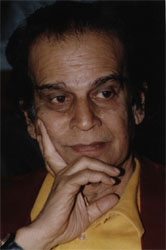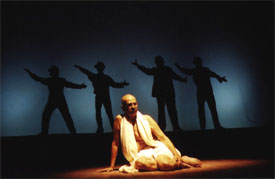 |
  |
 |
  |
Sachin Shankar: 1924-2005 The original grand-master - Ashish Mohan Khokar, Bangalore e-mail: khokar@vsnl.net Photos: Sashank Shankar July 30, 2005  The card simply said Sachin Shankar, choreographer, dada, friend, sachinda, kaka, sachinji, mama, dadu, kaku, teacher, guruji, peasant, swan, lord rama, shivaji, lord shiva, Gandhi...and the show goes on. It was not easy to make out if it was yet another production by the indefatigable Sachin Shankar who had created many productions in the last five decades or something else. It was only when I saw the fine print "Sachin Shankar 1924-2005," that I was shocked to numbness to realize one of my childhood hero was gone. Sachin da was no more. Upon calling his home in Mumbai, I was not greeted by a wailing family but an artistic one who sympathized with my sense of loss! Kumudini ji his partner in art and life, recalled my visit three years ago to make a documentation on him and fondly recalled his love for our family and without crying or seeking attention regaled how his end moments were: full of life, just as he lived. He was different. A trail-blazer who cared two-hoots for the system or establishment, Sachin Shankar was the most dynamic student of Uday Shankar. He was also his cousin! A long innings in the field of what was earlier called "ballet" and then re-termed "free-dance" Sachin provided the seeds for "contemporary dance" much before the Chandralekhas and Kumudinis arrived on stage. Sachin did not use classical dance styles but had developed his own vocabulary and movements akin to the "style" taught by Dada, who was so great that he did not want any credit for having created a style! Today's talents who tom-tom their little wares with much delight ought to learn from the example of these greats. In the death of Sachin Shankar on 10 May 2005, at Mumbai, due to a heart-attack, India has lost its last link with authentic Uday Shankar style of dance-art. He was eighty plus. Sachin Shankar was one of the first batch of students at Dada Uday Shankar's Almora studio when the institution was set up in the foothills of the Himalayas. He was the brightest of the batch which comprised such able men and women like Guru Dutt (the film-maker); Kameshwar (who married his teacher Zohra Segal); Mohan Saigal (the singer); Sardar Malik Mohamad (poet) and Narendra Sharma, the choreographer. The Almora school closed within years of its opening for various reasons, including of course the temperamental nature of its founder, Uday Shankar. Students had to leave and search for their own paths and this brought Sachin to Bombay after a brief flirtation with Calcutta. The city (of Mumbai) was new and happening; lots of people were making it home. It was the base for IPTA (Indian People's Theatre Association) movement and several leading lights of the theatre world were joining films. The film industry was itself in nascent stage. India was not yet independent! In such a scenario Sachin arrived in Mumbai with only dreams in his eyes and determination in his stout body and zealous mind. Born in Varanasi to Jitendra and Kalidevi Shankar, Sachin was brought up in an educated environment. His stint at Almora gave him a world-view because quite literally, the world came to Almora. From Almora he went to Calcutta but failing to establish himself there, brought him to the most happening city in India then, Mumbai. IPTA was an all-powerful medium of artistic expression and it was Sachin's association with IPTA that brought him to create works like Gandhi-Jinnah; Discovery of India (immortalized by another giant Shanti Bardhan) and The Kissan Struggle. During his three years with IPTA, he met Kumudini, a theatre actress performing in plays of Prithvi Theatre. She essayed historic roles in Ahuti and Paisa. She had also acted in films by Bimal Roy, like Maa, Parivar and Bandini. She was the heroine in Bandish but in real life she became Sachin's heroine in 1952 when they married. "In all the years I was married to him, I was also married to his art" her eyes moist when I drop in on her for offering condolences recently (July 22nd). She is at home remembering him and his work and energy. On the diwan her grandson, the handsome son of Sashank sits and takes notes for his sculpture class but listens intently as his grandmother tells many a tale. She tells of early Bombay days and how Sachinda helped create the Dancer's Guild of India. Sachin Shankar along with Shanti Bardhan, Ravi Shankar and Narendra Sharma quit IPTA due to ideological differences and formed a troupe of their own. Ravi was Uday Shankar's brother, hence also related to Sachin. Soon afterwards, Sachin and Narendra Sharma formed "New Stage" with the assistance of Martin Russel and George Keyt and staged the Ramayana. Kumudini played Sita and Sachin, Ram. Those days such mythological themes were very popular, recovering as India was from foreign rule. Many years later, the same Ramayana became base for Narendra Sharma's work with Bharatiya Kala Kendra in Delhi. Sachin was a lover of literature and strong personalities and both Hitler and Bal Thackeray inspired him! He took to realism on stage because there was so much make-believe happening on stage. Thus, Sachin's work did not have any intellectual pretense some of his associates and contemporaries like Narendra Sharma suffered from. Sachin created human and humane themes, easily accessible and understood. In 1953, Sachin launched his own ballet unit, supported by stalwart movie moghul Prithviraj Kapoor and well-known Marathi writer P V Atre. Sachin created popular ballets, over 40 in the last fifty years, some as vibrant as Cricket, Naa, Train, Kite Flying and some as deep as Shiva-Parvati, Rama, Chhatrapati Shivaji. Top musicians of the times, Vishnudas Shirali, Salil Chowdhury and Vijay Raghav Rao among others created scores for his ballets and Sachin was a much loved choreographer, dancer and leader. More works followed: Ghost, Volga to Ganga, Peasants Dream, Young India.... Sachinda had lasting relationships with many in the field and was not easily swayed. His lights men, his stagehands and his staff hero-worshipped him. His wife, Kumudini was a rock-like edifice in his life and he confessed without her, he would not have been able to do much in his artistic or personal life. Their son Sashank trained under Hrishikesh Mukherjee, no less and Sachinda had a kind word for all. When this author documented him three years ago (under a grant from the Ford Foundation), he found Sachinda in a very expansive mood and with dreams still in his eyes. He inspired those who came in contact with him and the warmth of his heart was genuine and sincere. He gave this author priceless photos and posters for the prestigious Mohan Khokar Dance Collection. That dancers and choreographers trust the family and repose confidence shows true standing that no one and nothing can take away.  This evergreen talent of India never won any official national level recognition except from Maharashtra. Delhi disdained over his razz-m-tazz and jazzy dance dismissing it as filmy, if not flimsy! In Delhi, positioning and image being more important than real work or worth, Sachin never won any award from sarkar except from the Akademi belatedly in 1992 when he was well past his prime. In Bombay, he ruled the roost and till his end - the third heart attack - he was scripting, creating and performing Gandhi, his last production. He died standing on his feet, on way to rehearsals. His partner of many decades Kumudini does not shed crocodile tears but continues to love him and love his mission. Sachin Shankar lives on. As I take leave, his grandson gives me a number to call (Alan Nazareth, the former DG of ICCR) in Bangalore. Yes, they are bringing Sachinda's last work - Gandhi - to Bangalore at Chowdaiah Hall on 2nd October 2005. As Sachin felt and always said "The show must go on" and it does! Sachin da will remain etched in our dance memory for long. He has earned that place of honour and respect. Critic, historian, editor and publisher of dance books, Ashish Mohan Khokar serves dance selflessly and has written over 30 books till date on Indian arts and spirituality. He is a columnist and contributor to many leading publications (India Today; Firstcity; Deccan Herald; The Week) and also dance critic of India's largest circulated English newspaper, The Times of India. He is the editor of attendance, India's yearbook on dance and publishes dance bios and books. His name finds over 1000 entries under a cursory Google search, a first for any dance critic of India, establishing his work and outreach, nationally and internationally. |